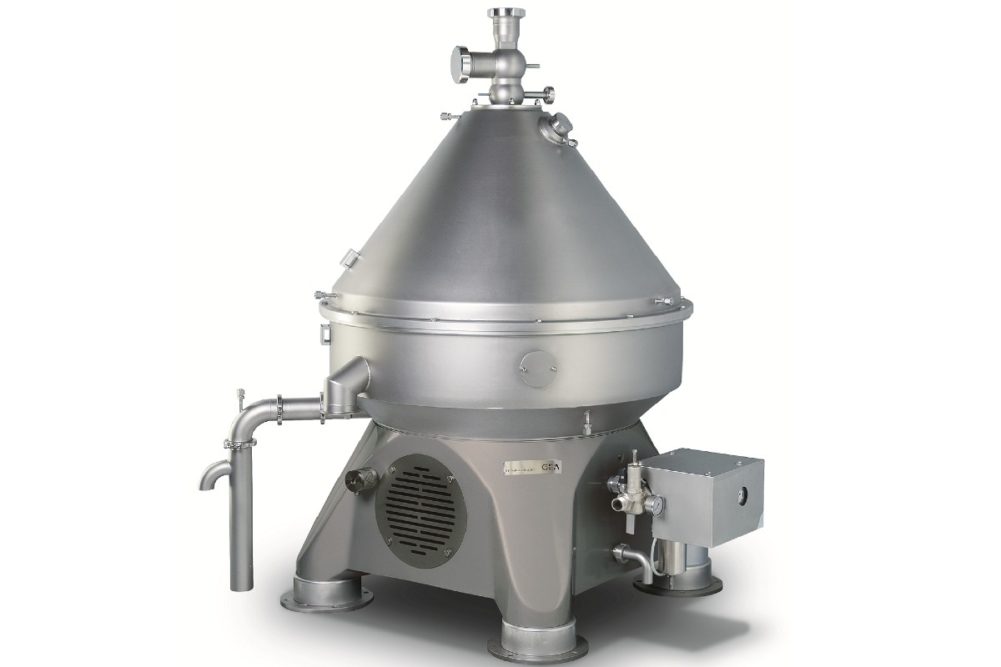A milk and cream separator is an important piece of industrial equipment that uses centrifugal force to remove cream from whole milk.
Today’s milk centrifugation technology helps companies produce the cleanest creams, milks, cheeses and powders, all while increasing production, improving consistency and reducing waste. Such separation is possible because milk and cream naturally like to separate.
Where it started
In the big picture, the centrifugal separator is a recent invention. For centuries, the technique for separating one substance from another was the natural process of sedimentation by gravity.
Sedimentation by gravity was also the original technique used in dairying to separate fat from milk. Milk fresh from the cow was left in a vessel and after some time the fat globules aggregated and floated to the surface where they formed a layer of cream on top of the milk that was then skimmed off by hand.
Just as gravity acts to naturally separate the milk and the cream, cream separators do the same thing — but much more quickly. Cream separators utilize centrifugal force by feeding the raw milk into a central spinning chamber.
Within this chamber are conical disk stacks that rotate in a drum, creating centrifugal force thousands of times stronger than gravity. The fat within the milk stays within the center of the drum, and the heavier skimmed milk is pushed to the edges.
Cream separators guarantee milk fat consistency and can also be modified to assist with clarification and the removal of foreign objects and pathogens.
Milk clarification
Clarification of raw milk and whey as they arrive at the dairy removes biological impurities such as cells and blood from milk, strips out any remaining cheese fines from whey, and clears liquid ingredients of any dirt and dust from the dairy or transportation.
In many cases, milk must be clarified on reception of the dairy to remove particles of dirt and somatic cells such as Leucocyte. This will reduce the presence of listeria which is trapped inside the leucocyte. While the milk clarifier can operate with cold or warm milk, clarification efficiency improves at higher temperatures. Centrifuges for milk separation – or skimming -- also perform clarification, but their efficiency is low compared with milk clarifiers.
High-speed disc stack centrifuges play three key roles in standardized milk production including clarification to remove foreign matter such as hair, stray cow cells and dirt. They also aid in purification, pulling the butterfat from the raw milk in order to produce skim milk and cream, and standardization, which regulates the fat content of finished milk by blending some cream back in, producing 1% milk, 2% milk or half-and-half.
These centrifugal separation operations give milk producers a lot of control, allowing them to ensure the safety of their products while increasing yields and controlling the quality.
Warm vs. cold milk skimming
Raw milk and whey undergo both pasteurization and cream separation prior to use as the basis for milk powder products. Separating the cream to generate non-fat milk can be carried out using either a warm milk separation process or a cold milk process. Using the cold process makes it possible for the resulting skim milk to be used as the basis for products such as low heat formulas.
Milk skimming during pasteurization is the most common centrifugal separator application in dairies. The product temperature should normally be kept between 113°F and 131°F, in order to ensure optimal skimming efficiency.
Cold milk separation at greater than 39.2 °F takes place in a number of processes including cheese making using unpasteurized milk, pre-standardization and cream production.
Cold milk separation enables significant savings in energy and thermal equipment such as heat exchangers. Cold milk skimming efficiency is lower than for warm milk. Skimming efficiency improves by increasing temperature and/or reducing flowrate.
Maintenance
Running a cost-effective cream separator is not only about upfront costs, but also the efficiency of its day-to-day operation. It is recommended that companies train employees in best practices for starting and stopping your cream separator equipment, as well as clean-in-place (CIP) protocols and troubleshooting. This can ensure employees aren’t making time- and money-wasting errors.
Additionally, regular cream separator maintenance should happen about two times per year, which can extend the lifespan of the equipment.
Processors can also consider upgrading the automation cream separators. Automation technology can have an exceptional impact on equipment efficiency.

